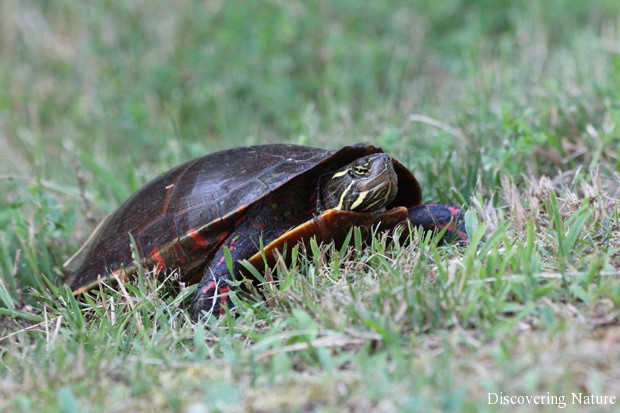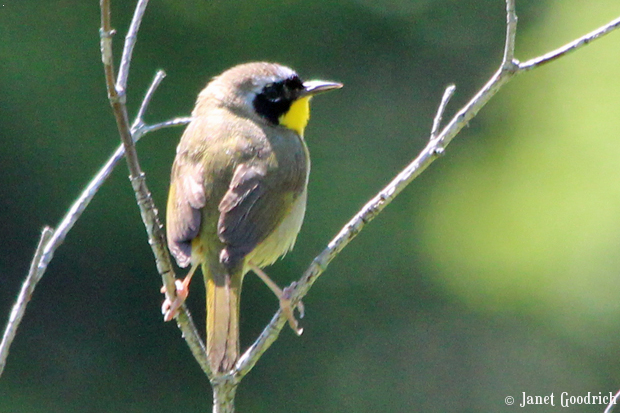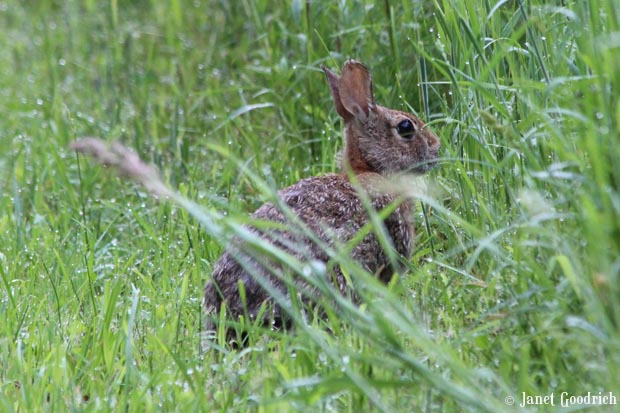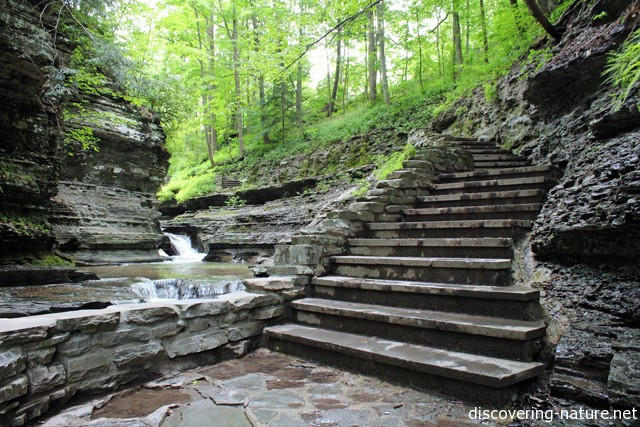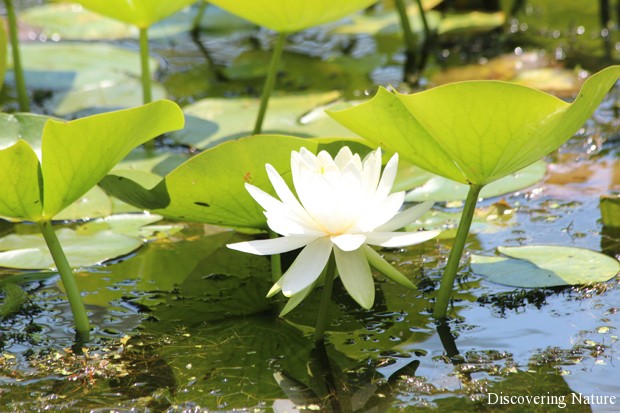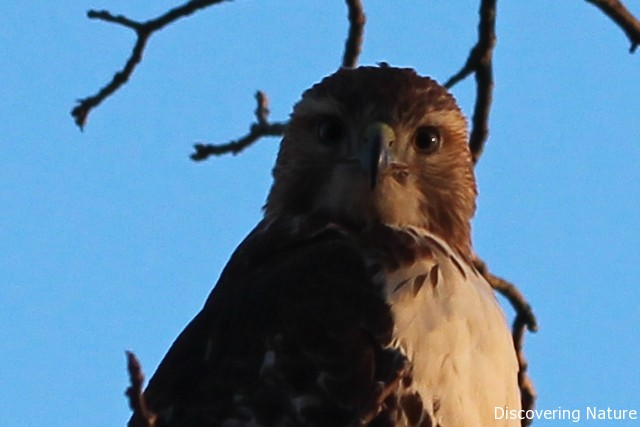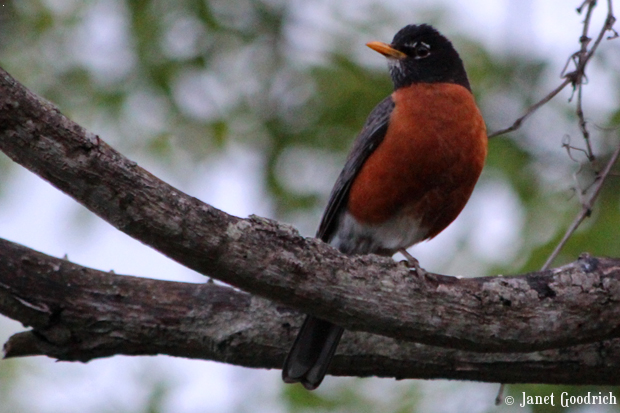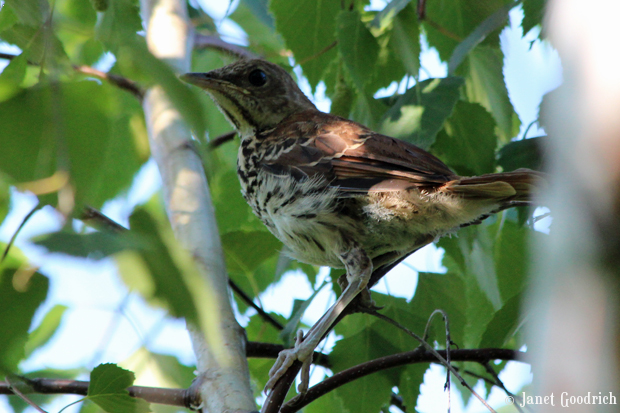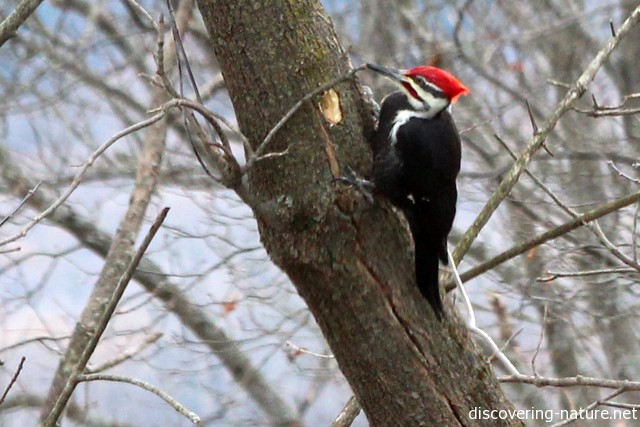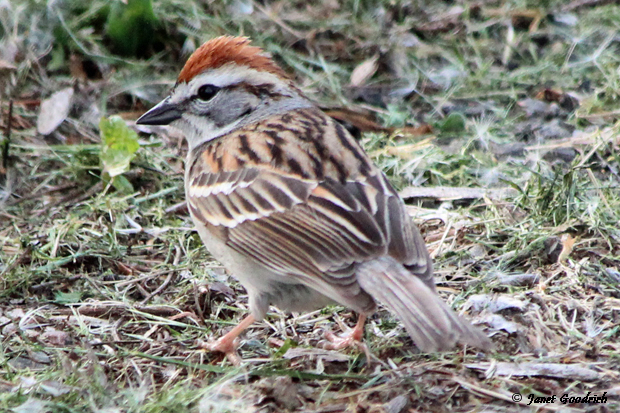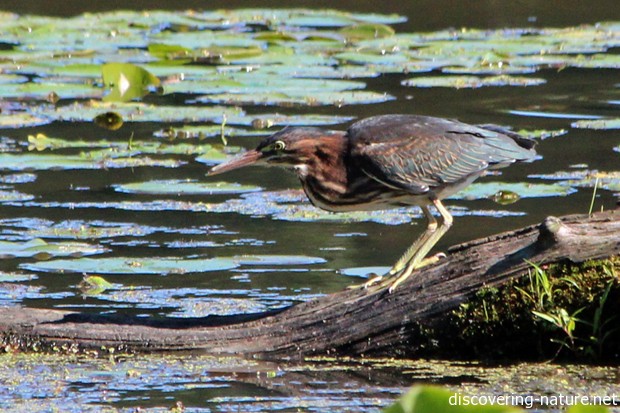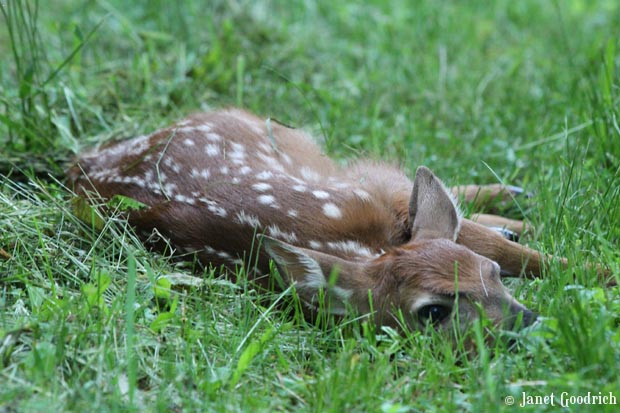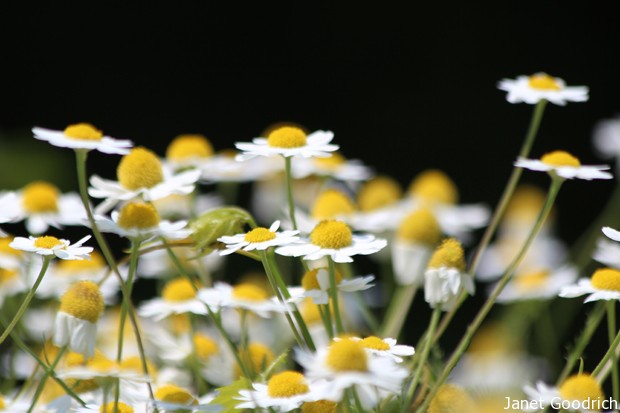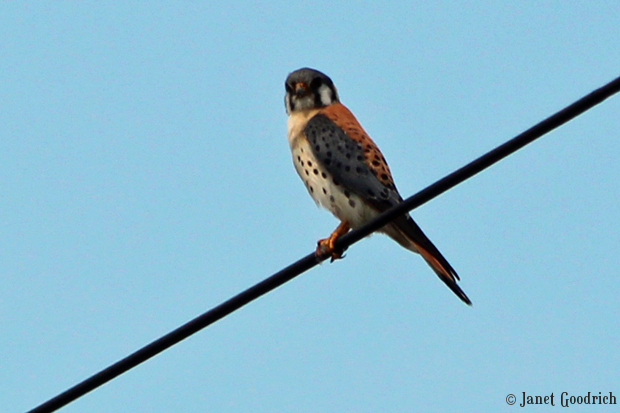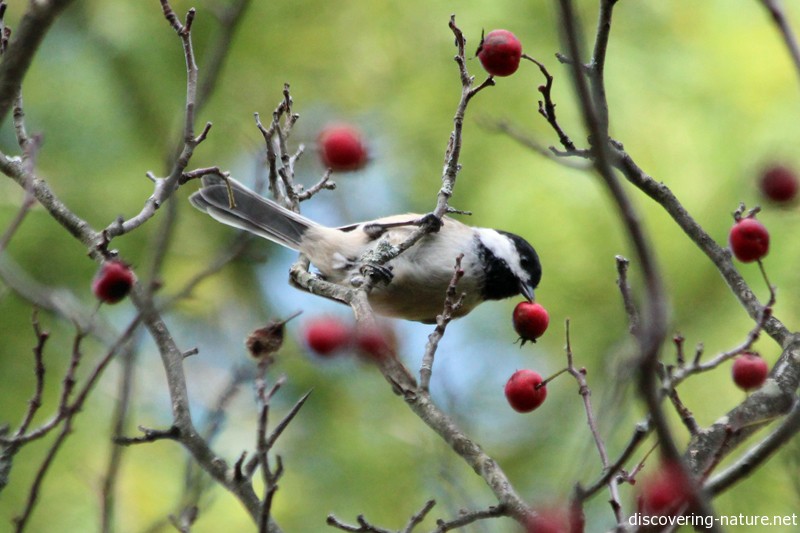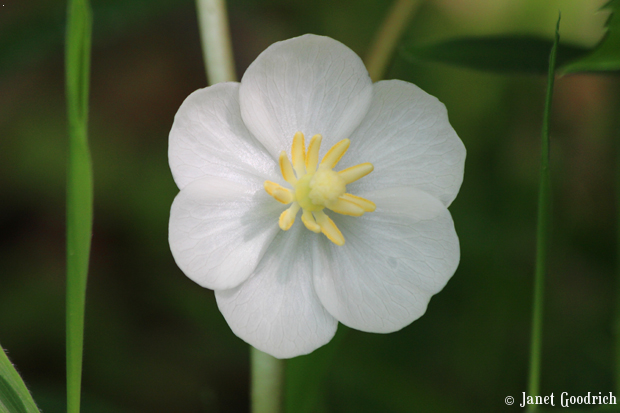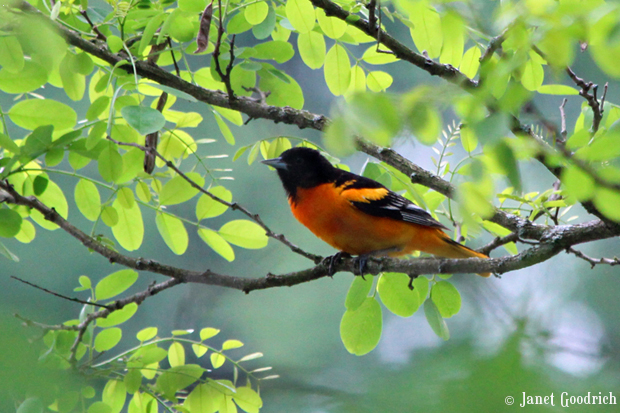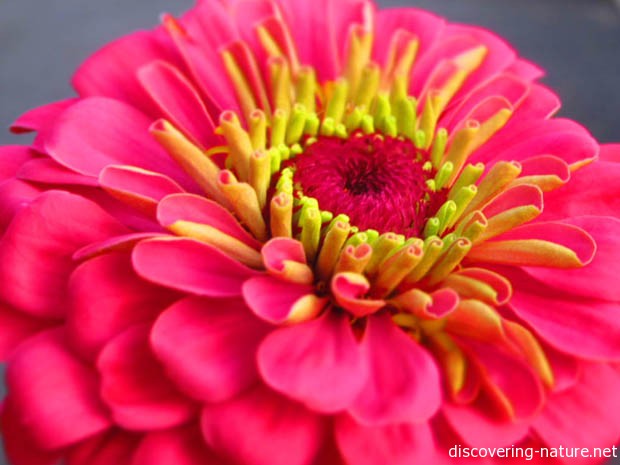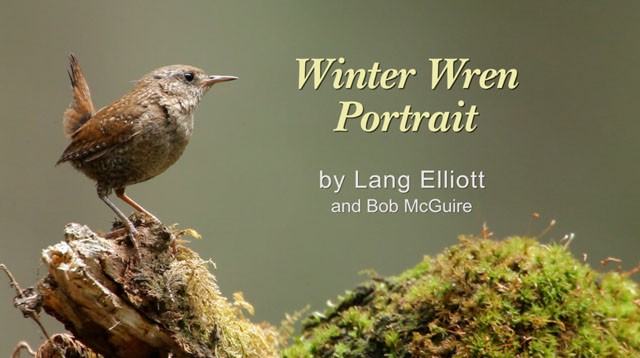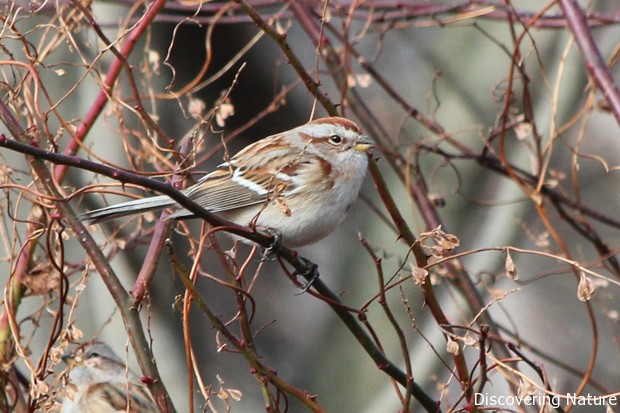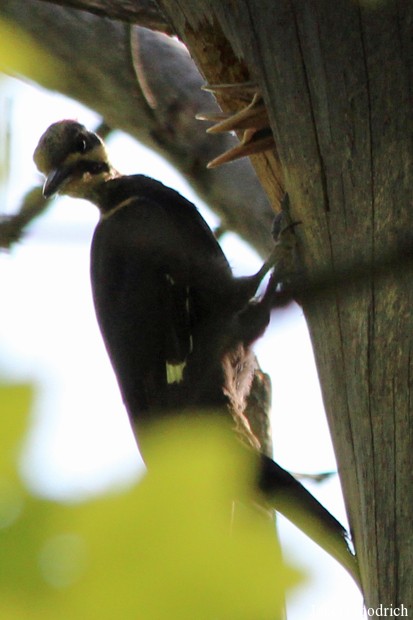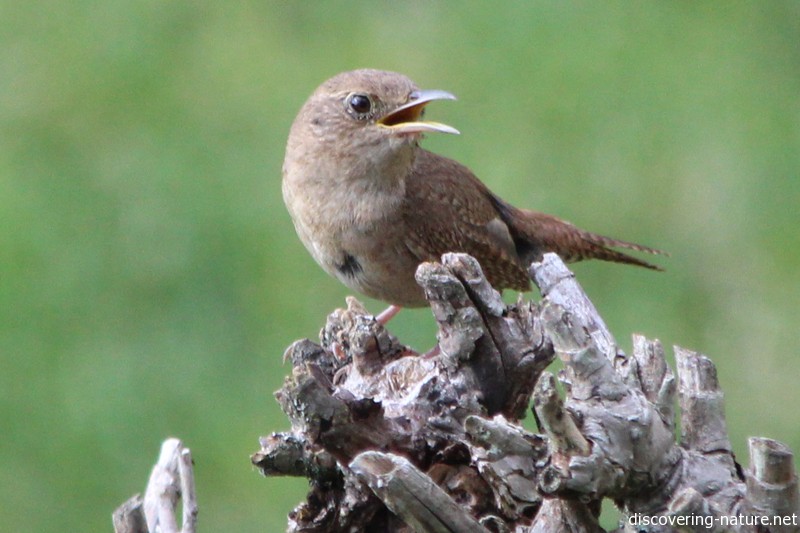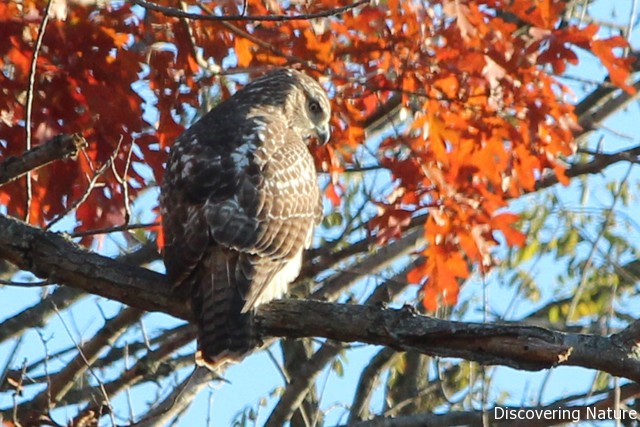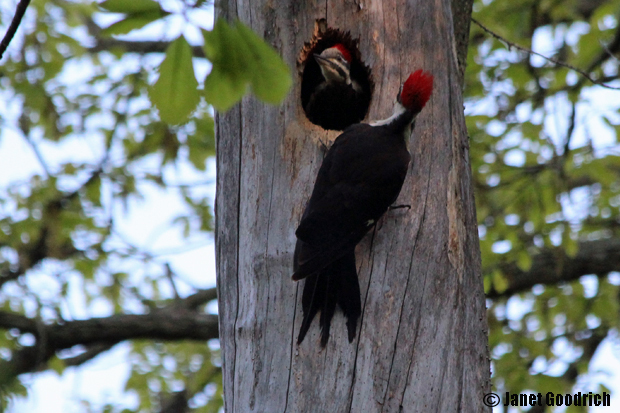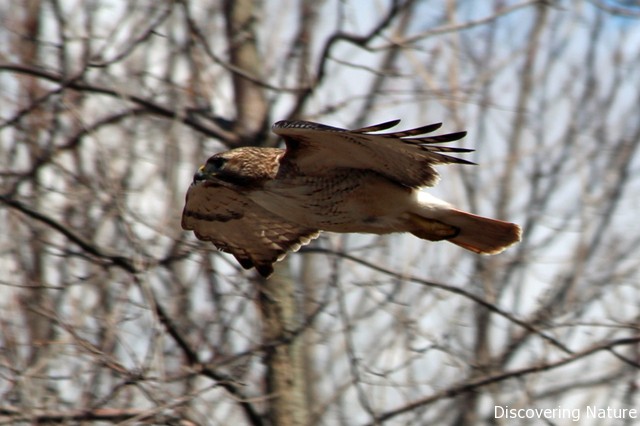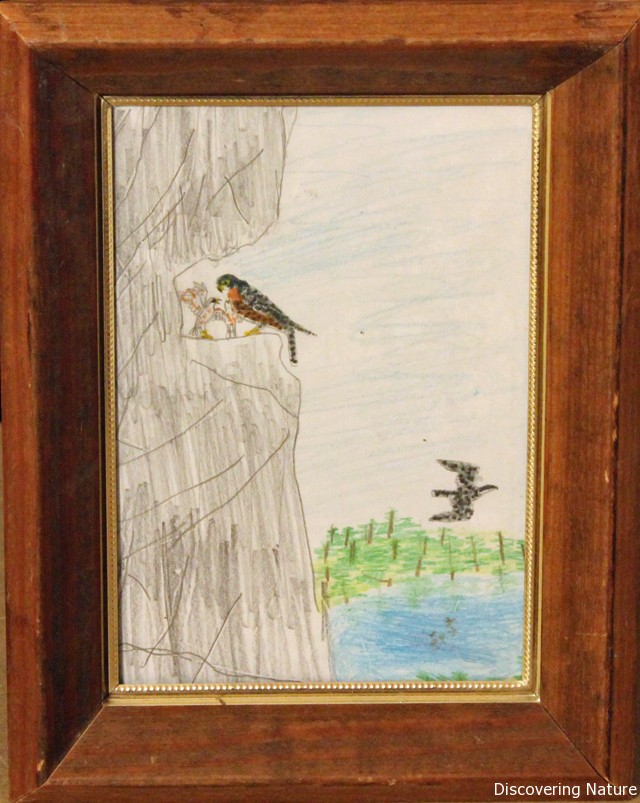Walks
-
Impromptu Lesson
My daughter and I went to a popular walking trail last night, looking for warblers. We saw a few interesting birds, and on the way in we also saw this painted turtle out in the open.
There are wetlands all around the trail, so we didn’t think much of it. We figured it was crossing the trail to find a spot lay eggs. But on the way back, a couple were seated on the grass beside the turtle, and they told us that she was laying eggs.
Indeed she was — or rather, preparing to. It was a neat experience to watch her laboriously digging the hole with her hind legs.
We’ve read that turtles lay eggs, but it was a very different experience to watch her in action for awhile. She would scrape deeply with one leg, shift, scrape deeply with the other, and then moisten the cavity periodically with her own fluids. She was intent on her work and completely undaunted by the four spectators she had accumulated.
We observed her for 10 minutes or so, then went on our way. This morning, I went running down at the same trail, and when I checked the spot it looked like this.
Why did she choose that spot — in mown grass along a paved trail, in not-particularly-moist ground? Presumably the eggs are below-ground, 5-10 cm according to what I read this morning. Sometimes painted turtles dig “false nests” before settling on the site where they actually lay their eggs, but without digging in myself I’ll never know. She certainly had done some serious excavation and turned up all those small stones.
Apparently the eggs will hatch in August or September, and the baby turtles may not come out, but may arrange themselves symmetrically in the nest and winter there. We won’t expect any juvenile turtle sightings anytime soon! But what good moment to have passed by.
-
Celebrity Herons
We went to Sapsucker Woods the other day and saw the bowl-full-of teenagers (a.k.a. herons’ nest) chatting and looking around out in the pond.
Then we noticed what they were viewing from their balcony seats. Down in the pond, one of the adult herons looked to the right…
…and looked to the left…
…and looked at us.

"Oh goody. Another photographer." So very patient. We waited and watched and were eventually reminded that all things come to those who wait.
In addition to its children watching from the nest, there is a dragonfly watching the whole show in the right foreground. Someone else was watching, too.
Who was in his turn being observed by others…

Frog Paparazzi One of the funniest things I saw was a frog literally racing across the lily pads directly in front of the hunting heron. I saw at least two frogs do this. Were they adolescents daring one another to ring the doorbell of their grumpy neighbor? The stakes were pretty high for the frogs! But apparently the heron had an appetite for fish.
While watching the heron, several different dragonflies demanded our attention as well. There were this one,
this one,
this one,
and these two shameless exhibitionists. The female is laying eggs, we guessed.
We heard many more birds than we saw. But this is a new one for me, a great crested flycatcher.
The other new sighting for me was a pair of American redstarts. I’ve seen the male before, but not the female.
We were very hot by the time our stroll ended, so we ate the lunch we’d brought and drank gallons of water before heading back home. Older Daughter enjoyed the heron fishing the most, Younger Daughter liked the frogs, and I liked the redstarts. So there was something for everyone and more besides — as usual!
-
Serenity Wood
I took a walk today in a favorite place called the Serenity Wood. It was very hot, and I saw many things as I explored woods and meadows: yellow-throats, house wrens, an eastern towhee, a Baltimore oriole. There were deer tracks, coyote tracks, and raccoon tracks in the mud. Robins and sparrows and yellow warblers and chestnut-sided warblers hopped among the leaves. And there were catbirds — always catbirds.
I heard a brown thrasher at one point, and later on I thought this bird, startled up out of the grass beside the trail, was a thrasher. But it was quiet, and it had a shorter tail. I think it was a wood thrush, nesting in the grass. I was delighted to make her acquaintance!
*Edited to add: I’m thinking it may be more likely that this is a hermit thrush, because of the striping on the throat. Very pleased to meet this beautiful songster!
This tiny pearl crescent butterfly was a welcome sight too. Exquisite.
Not everyone is so picturesque, of course. And though the woods were full of noise — squeaking chipmunks, an ovenbird, red-eyed vireos, rustling leaves — some were in a more quiet, meditative mood.
He owes me a smile for not stepping on him as he lay there in the middle of the trail. No gratitude. (It must be confessed: I like toads. As a child I would spend whole afternoons collecting them in coffee cans, then let them all go at the end of the day. I was certain they recognized me as their benefactress.)
I saw the fawn I had the close encounter with last week, too. It might have been a different one, but I prefer to think it’s the same one, developing on schedule. Unbeknownst to me, I was standing right next to it in the trail; it was in the long grass beside me. I didn’t realize it till I gave up on trying to take a picture of the towhee, and took a step. The little fawn thrashed to its feet and disappeared into the brush with a flick of its tail. I was glad… I want it to know enough to run from strange critters like humans.
It was a nice, leisurely walk — perfect outing for a Sunday afternoon.

Yellow-striped hunter -
Why nature? Why now?
I have met with but one or two persons in the course of my life who understood the art of Walking, that is, of taking walks, who had a genius, so to speak, for sauntering; which word is beautifully derived “from idle people who roved about the country, in the middle ages, and asked charity, under pretence of going à la sainte terre” — to the holy land, till the children exclaimed, “There goes a sainte-terrer“, a saunterer — a holy-lander. They who never go to the holy land in their walks, as they pretend, are indeed mere idlers and vagabonds, but they who do go there are saunterers in the good sense, such as I mean. Some, however, would derive the word from sans terre, without land or a home, which, therefore, in the good sense, will mean, having no particular home, but equally at home everywhere. For this is the secret of successful sauntering. He who sits still in a house all the time may be the greatest vagrant of all, but the Saunterer, in the good sense, is no more vagrant than the meandering river, which is all the while sedulously seeking the shortest course to the sea. But I prefer the first, which indeed is the most probable derivation. For every walk is a sort of crusade, preached by some Peter the Hermit in us, to go forth and reconquer this holy land from the hands of the Infidels. (Thoreau, “Walking”)
 Why have I turned so intensely to nature study this year?
Why have I turned so intensely to nature study this year?I go for walks to drink in the beauty of sight and sound. (I’d say smell, but I don’t have much of a sense of smell. I can smell cookies baking, chicken in the oven, skunk. Most other odors are lost on me.)
I go for walks like a drug addict. There is something saving about it that doesn’t get old.
I go for walks because those times seem like the most real experiences of my life. There is nothing of the monotonous hum of technology about it. I confess to a loneliness these days, a loneliness that corresponds to the increasing presence of technology, even in our relationships. Wendell Berry writes in Remembering about a man who has lost a hand to a threshing machine. His point of contact with the world is no longer flesh-and-blood, but mechanized, and the coldness of it creeps toward his heart. It was written in 1988, but it seems prophetic as a picture of modern relationships — to the earth, the each other, to our own souls.
 I wonder sometimes how my children’s experience differs from my own as a child. Once recently, when my computer chimed that I had gotten an email, I remarked absently that there was no email when I was a child. “Really?” both girls asked in unison.
I wonder sometimes how my children’s experience differs from my own as a child. Once recently, when my computer chimed that I had gotten an email, I remarked absently that there was no email when I was a child. “Really?” both girls asked in unison.Startled, I looked at them. “Really,” I said. “My mom never checked email when I was growing up. There was no texting either. No cell phones. When Daddy and I got married, Grandma and Grandpa had a cell phone, but you had to pull over and put the antenna on the roof for it to work.”
Wide-eyed fascination from the girls.
“If someone called you, and you weren’t home, they just had to wait and try again later. Then they invented answering machines, and people could leave a message asking you to call them back. If a friend called me, I might not be the one who answered. They would have to say, ‘Hello, this is Christina. Is Janet there?’ And whoever would answer the phone might say, ‘Yes, just a minute,’ or ‘No, she’s not.’ Now people can call each other all the time.”
 I stopped and thought, this is progress?
I stopped and thought, this is progress?Thoreau was not the first nature writer, but he is a watershed of sorts, the one after whom so many of his successors have modelled themselves. I’ve been aware of Thoreau for years, yet only now am I recognizing that in many ways he speaks for me. It was Thoreau who said, “I went to the woods because I wished to live deliberately.” I go for similar reasons. It seems more real than the insulated world of scheduled activity and technological efficiency — neither of which offer much real connection. Linked with the escape into the woods is family connection, since my daughters, and my husband when he’s able, often accompany me. It’s good all around.
Sometimes, we come across other people there — other saunterers, as Thoreau would call them: photographers, birders, college students, people old and young. I’ve enjoyed the conversations that have emerged in these places. Mostly we talk about the walk we’re on: “Seen anything?” they’ll ask. Or I will. And we compare notes. Once, as the girls and I watched in delight as a muskrat swam beneath us, a college student came to see what we were looking at. “I’ve never seen that before,” he said in wonder. I’ve gotten photography advice from camera-bearers I’ve encountered on walks, as well as testimony of the wonders of particular trails. Recently I saw a yellow-headed blackbird, a western bird defending territory far off course here in the Northeast, because of a chance encounter with another birder along the trail. Going to the place he had described to see the bird, I met another walker who invited the girls and me to come to their naturalist club’s guided birdsong walks on Saturdays. It was a string of positive encounters.
 But even alone, it is a restorative experience to go for a walk. The natural setting is inexhaustibly interesting. So many sounds. So many movements and colors. None of them depend on me; but if I am quiet and nonthreatening, I can have a place there, witnessing the life and death stories unfolding all around me. It’s humbling to recognize all that is going on there. And it’s a disburdening of the self, an exit from the interior world through the doorway of the observing eye. I don’t really think about myself or my problems; I just look and listen.
But even alone, it is a restorative experience to go for a walk. The natural setting is inexhaustibly interesting. So many sounds. So many movements and colors. None of them depend on me; but if I am quiet and nonthreatening, I can have a place there, witnessing the life and death stories unfolding all around me. It’s humbling to recognize all that is going on there. And it’s a disburdening of the self, an exit from the interior world through the doorway of the observing eye. I don’t really think about myself or my problems; I just look and listen.Thoreau says something similar in “Walking”:
I am alarmed when it happens that I have walked a mile into the woods bodily, without getting there in spirit. In my afternoon walk I would fain forget all my morning occupations, and my obligations to society. But it sometimes happens that I cannot easily shake off the village. The thought of some work will run in my head, and I am not where my body is; I am out of my senses. In my walks I would fain return to my senses. What business have I in the woods, if I am thinking of something out of the woods?
 I don’t know what neat conclusion I can come to here, except to return to my original question: why such a keen interest in nature these days? Because it’s one of the few places in my life that seem (here comes the word again) real, and we are made for the real. Other settings seem to be mostly blather and abstraction. But nature is spinning out its myriad activities and relationships all the time, and we can see some of it happening if we want to. I can’t really say it better than that.
I don’t know what neat conclusion I can come to here, except to return to my original question: why such a keen interest in nature these days? Because it’s one of the few places in my life that seem (here comes the word again) real, and we are made for the real. Other settings seem to be mostly blather and abstraction. But nature is spinning out its myriad activities and relationships all the time, and we can see some of it happening if we want to. I can’t really say it better than that.Maybe finding a better way to say it is one of the reasons I started this blog.
-
Morning magic
This morning I took an early morning walk in the woods. The air was alive with birdsong, and at one point I found myself lured up a trail by the voice of a brown thrasher. This is a bird I’ve just started noticing this year, and its unbroken chatter always makes me smile. It’s the first bird that’s ever tempted me to use the word “loquacious.”
I never did get my eye on the thrasher. But as I neared a bend in the trail, I heard a sudden, panicked snort, followed by thudding and swishing bushes. I’d started a deer.
Rounding the bend, I saw something that startled me: something brown and flattened-looking in the trail. A few steps closer, I saw spots. A fawn. It lay at an awkward angle, and I assumed it was dead. Wondering if I’d interrupted a coyote just starting its breakfast, I reached for my Mace (always carried, never used) and considered turning around. But what if it was not dead, only injured? I couldn’t walk away till I made sure.
A little closer, and I saw that it was breathing.
I remembered the stories I’d heard about fawns so conditioned to lie still where their mothers left them that they wouldn’t move out of the path of an oncoming combine. Horrible. Yet if these stories were true, it was no real wonder that the fawn didn’t move when I approached. I walked carefully past it, thinking the gentlest and most encouraging thoughts I could, and resisting the temptation to stroke its head. It remained motionless the whole time.

Using a zoom here -- I wasn't sticking my camera right under the little creature's nose. No word seems right to describe the experience.
Later, I read what I could find about white-tailed deer and their fawns (here and here, for starters). I felt reassured that this little fawn was just doing what white-tails do, right down to its awkward position in the grass. I read that the does leave their new fawns in places with low vegetation, and there they lie, heads flattened down as much as possible. The youngest ones remain motionless even when another animal comes close. If there are two or three fawns, the doe will hide them in separate places.
This morning, with only the combine stories in mind to support the notion that the fawn was behaving normally, I walked on down the trail and then waited a minute to see if the doe returned. She had made a wide circle, and through the brush on the other side of the trail from where she’d run away, she came haltingly.
That’s her, flaring her nostrils in another loud snort of alarm at the sight of me. Not wanting to bother this little family unit any further, I headed off.
I couldn’t help but notice the music coming from the surrounding woods. As a lullaby for a young deer, it was superior to any mobile I ever found for my daughters. I recorded a few of the songs, and the sound quality is all right though my video skills are dismal. (I wish I knew how to record sound without video.)
There was the thrasher, who continued endlessly with his one-sided conversation.
Somewhere, a veery sang — a bird I’ve never seen, but whose song I’ve come to recognize. To me, it’s a sound that belongs to secluded places.
And a thrush — I think a hermit thrush, but maybe a wood thrush — sang its lonesome and lovely song. At around the halfway point, the snorts of another startled deer (or two) that had spotted me can be heard.
There were other sights and sounds too, but the fawn was the highlight. One source I looked at said that fawns who survive their first week of life stand a good chance. I’m pulling for you, little one.
-
Scenes from Ithaca
On the way to Ithaca the other day, we saw this American kestrel hunting beside the road. They are such beautiful little birds! It was perched on a lightpost, then it fluttered to the power line, studying the ground in search of lunch.
He’s so beautifully colored; he looks painted. We see them sometimes hovering as they hunt, but this one put on no such show for us.
Having survived the decision to stop beside a busy thoroughfare to snap pictures of a kestrel, we went on to Taughannock Falls for a hike.
We took the trail up to the top of the falls and looked down on some of the smaller falls from above.
We met some turkey vultures along the rim.
It was a walk of a few miles, and though the overcast wasn’t great for photos, it made the heat much more bearable. The girls were ready to wade when we got back to the bottom, so we joined the rest of the multitude of people and polliwogs there, splashing around.
We hadn’t seen any songbirds, though we’d heard a few insistent warblers up along the rim. But after we packed away the cameras and went across the road to use the rest rooms before leaving, the trees were full of birds: cedar waxwings, warbling vireos, and I even caught a glimpse of an American redstart.
We visited the hawks after that, and as we were leaving Ithaca we made a brief diversion to Sapsucker Woods. The Visitor Center was closed for the day, and though the trails were still open, it all had the peaceful atmosphere of a place being reclaimed by its inhabitants. A squirrel sunned itself on a railing and watched us drowsily. A ruby-throated hummingbird — a species I have seldom seen in any other mood than territorial fury — shook out its feathers and rested. Turtles eyed us from the grass. A couple of orioles caroled from treetops. Everything about the scene radiated a quieting spirit.

No visit would be complete without a look at these guys. 
This guy ran full-tilt toward my daughter -- then turned and high-tailed it away when he saw himself being photographed! 
Smile, friend! 
This turtle was sunning itself in the middle of the pavement, so we moved him. All in all it was a full day, rich in beauty. We always have the sense of barely scratching the surface when we visit Ithaca.
-
Walk at the Pond
The sun was out yesterday morning, and I urged the girls on in their schoolwork, dangling the carrot of a walk in the sun. They rose to the challenge, and we headed off in good time.
First to sound the alarm was this guy: “Humans! Humans!”
Apparently he was ignored, because just beyond him we saw a couple of green herons.

This one looked pretty typical... 
...till the wind blew and gave it a punk makeover. There was a whole cavalcade of geese camped out on the berm across the pond. They made an impressive racket as they took off. We could almost feel the wind from their beating wings.
There were some other water birds around too.
There were several great blue herons there — 4 or 5. They may be feeding young at the heronry down the river.
The bracken was particularly lush…
And there were some wildflowers around. Learning the names is helping me to feel more like I belong in this place.

Forget-me-nots 
Blue flags 
Bramble (I think) 
Mystery flower Back at the car, the oriole that usually hangs out in Old Man Willow was humming his way through lunch. I thought that the Burgess Bird Book named the oriole “Glory,” but it’s actually “Goldie.” I prefer Glory. It doesn’t get any more glorious than this colorful bird with his agreeable warble.

Glory the Oriole By then the sun was retreating behind a bank of clouds, so the flash of fire from Mr. Oriole was all the more welcome.
When we got home, Younger Daughter requested tree swallow coloring pages. Older Daughter requested a library book on caring for injured robins (for reasons I’ll share in a later post). I’ve been slacking on official nature journal pages, but I think we should probably get back into them. They’re not necessary for learning, I don’t think, and only sometimes are they an aid to seeing. But they do document the experiences of our various walks together. Someday I want the girls to have them to look back through. Once they learn the name of a flower or the habits of a bird, they will remember. But the particular treasures of particular walks may fade or get mixed up over time.
-
Evening
Last night, my older daughter and I went for a walk at a nearby preserve called Brick Pond. We loved seeing this rainbow!
Other sights: great blue herons, green herons, wood ducks, a mallard and her brood, a killdeer, a muskrat, geese with goslings, tons of polliwogs, and an enormous bass. It must have been 6 or 7 inches deep, from the top of its head to its chin. There were a couple of kingfishers at work, and we heard yellow warblers and a Baltimore oriole. Two deer fled when they saw us coming. The first blue flag of the season bloomed by itself among some ferns. Any number of familiar birds — robins, catbirds, red-winged blackbirds, grackels, chickadees, woodpeckers — discussed us. Some kind of flycatcher fluttered overhead, but the light was too poor to identify it — or to take many photos.
-
Beaks!
Just after I expressed my wish to see little beaks at some point at the pileated nest, I did!
My husband and kids and I were taking my parents for a walk along the trail, and Mrs. P appeared.
She was there for a few minutes, then left. Mr P appeared then and went inside — briefly.
I’ve read that clutch size is typically 4 eggs, though it can vary. It’s likely that there are more youngsters in there.
I also read that adults have yellow eyes. This is true of the male, but the female’s eyes look pretty dark. But I’ll reserve judgment unless and until I get some better pictures.
This site is helpful on pileated woodpeckers.
-
Pileated Pair
Yesterday I crouched in ferny woods for 45 minutes or so, waiting for the pileated woodpeckers to show themselves. It was 6:30 in the morning when I settled myself on a damp fallen log in the tick-infested woods, within view of the nest, but not too close.
I watched red-winged blackbirds chasing one another and sounding off. A broad-winged hawk lit on a branch over my head and gave me one brief, piercing look before taking flight to escape some marauding grackels. By 7:00 I was getting chilled, my feet were falling asleep, and my trick neck was threatening to jam as I looked up wistfully at the woodpecker cavity.
Suddenly, Mrs. Pileated appeared, a silhouette against the sky on a neighboring tree. She pecked away quietly, making sure the coast was clear, then whooshed to the tree and went inside.
She wasn’t in there long before Mr. Pileated appeared. He surveyed the scene carefully from several different trees, including one right in front of me.
Then he made his move.
I left, being careful to use a different route than the one I took coming in.
It was thrilling. I think of pileated woodpeckers as belonging to the wilderness, and I felt privileged to see them going through their routines together. I still haven’t seen any little beaks poking out. How many nestlings do they have? When will they fledge? I don’t want to hound them by coming too often, but I hope I’ll see a glimpse of the youngsters at some point. I’ve never seen a juvenile pileated woodpecker.
What is it that drives me to such an activity early on a Saturday morning? I’ve been thinking about it today. My woodland explorations have come to seem like some of the most real moments of my life. It’s the ultimate “unplugged” experience, for one thing. The sights and sounds and smells are all vivid and direct. For another, there is no pretense in nature. All around me are creatures busy at the task of survival. They need food; they need to mate and raise young; they need to stake out territory to provide for themselves. It’s life and death for them, and it exposes many of my human rituals and “concerns” as simply trivial. Which brings us to humility. It’s humbling to get these glimpses of the complexity and variety and beauty of the non-human world. Humbling, and deeply inspiring.
What better way could there be to start a weekend?
